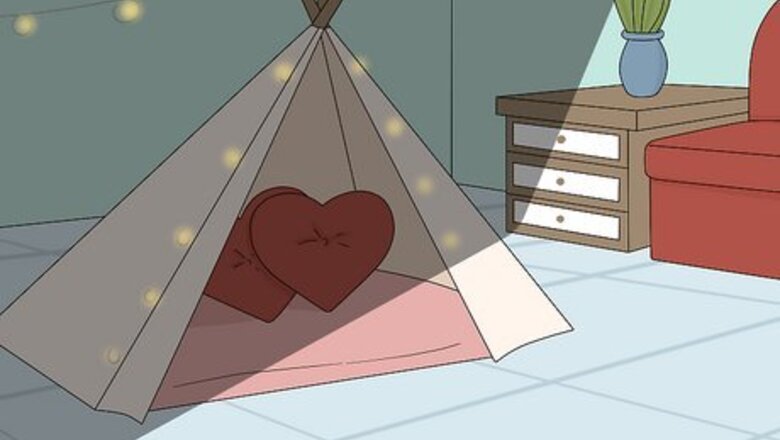
views
Choose the location of the final treasure first.
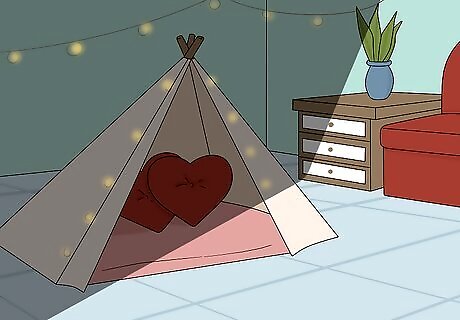
The easiest way to plan your treasure hunt is to work backward. Pick a place that has meaning for you as a couple. Your treasure hunt might end at your favorite restaurant, where you had your first date, or where you had your first kiss. Pick a final spot where you can set up everything you need to. Make sure you get permission if you're going to set up in a business, such as a restaurant or café. You might plan your treasure hunt based on where your partner is naturally headed. For example, if you're going to start the hunt with your partner at their workplace, you might have the final stop be at home—that way they can follow your path home from work.
Map out your route.
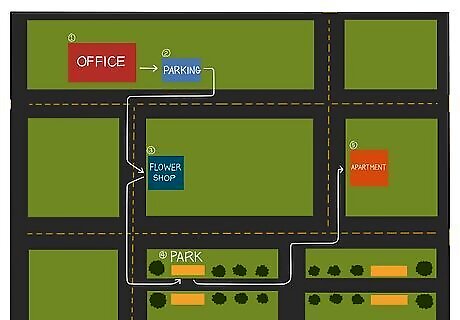
Choose 4-8 stops for a hunt that lasts 1-2 hours. Make a list of places you want to include as stops. If they're scattered throughout your city, use a trip-planning app, such as Google Maps, to easily find a logical route. For example, if you're choosing stops that are significant to your relationship, you might include the place where you first met or had your first date, your favorite café or restaurant, and the place where you had your first kiss. You don't have to create a long route if you don't want to. You can have a short treasure hunt inside your own home—no map necessary.
Choose small gifts to plant at each stop.
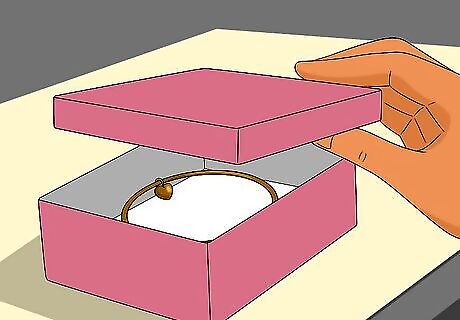
A small gift at each stop makes your partner feel special. Your traditional romantic gifts, such as candy and flowers, work great for this. You might also use the gifts themselves as clues leading up to the final treasure. For example, if your final treasure is a ski trip, you might include gloves at one stop, a hat at the next, then a scarf, and so on. Try things that have special meaning to your partner as well. For example, if your partner collects acrylic pins, you might get a special pin and include it with the clue card at each stop.
Design the cards to write your clues on.
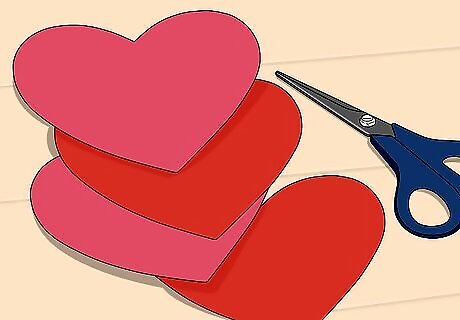
Use thick cardstock or construction paper in bright colors that stand out. If you have a theme in mind, you can cut your clues into a shape that fits your theme. You might even draw a picture or design on each one—this is your chance to let your creative juices flow! For example, if you're doing the treasure hunt for Valentine's Day, you might cut red paper into a heart shape. You could also use different pastel colors to mimic candy hearts. You could also type the clues into text boxes and print them out, then cut around the words. If you go this route, you can also find graphics online to copy and use (which is great if you're not much of an artist yourself).
Introduce the idea of the hunt in the first clue.
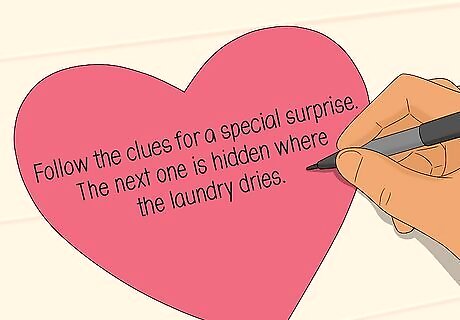
Tell your partner what's going on and get them excited. Make the first clue easier than the rest to get your partner off and running fairly quickly and feeling confident about their ability to find and decipher the next clue. Here are some examples you can adapt and personalize: "Get ready for an adventure that can't be beat! To find the next clue, you'll have to turn up the heat." (The second clue is hidden next to or inside the thermostat.) "Follow the clues for a special surprise. The next one is hidden where the laundry dries." (Clue is in the dryer or on the clothesline outside.) "To discover your gift requires a little work—head to where you practice your clean and jerk." (Next clue is at your partner's gym.)
Write riddle clues if your partner likes to solve puzzles.
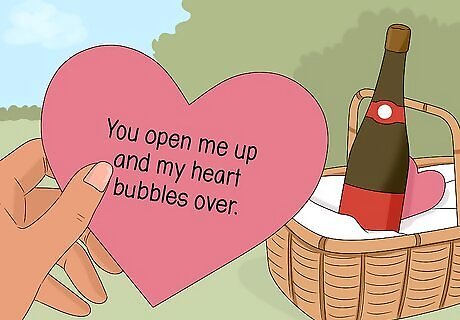
Words with double meanings make riddles easier. You can also write riddles based on the characteristics of something near the clue or the place where the clue is located. Here are some ideas to get you going: "You open me up and my heart bubbles over." (The clue is near a bottle of champagne or bubble bath.) "Go here if you want to spice things up outside the bedroom." (The clue is near the spice rack in the kitchen, or at your partner's favorite spice store.) "I greet you every day without saying a word." (The clue is under the welcome mat.)
Use rhyming clues that point directly to the next spot.
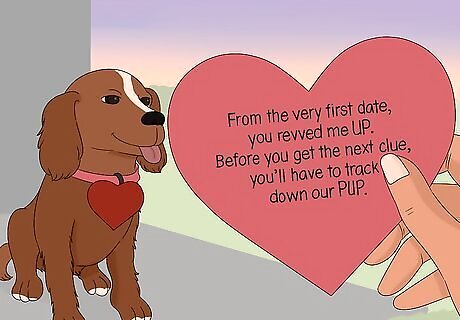
You don't want your partner to waste time trying to figure out a riddle. To make it easier to find rhymes, stick to simple words with common endings that have a lot of options. Here are some examples you can adapt to fit your hunt: "You've tracked me this far—man, you're good! To find the next clue, search under the hood." (The next clue is under the hood of the car.) "From the very first date, you revved me up. Before you get the next clue, you'll have to track down our pup." (The next clue is attached to your dog's collar.) "There's no denying you've captured my heart. Look for the next clue behind our favorite art." (The next clue is behind a favorite painting or other piece of art.)
Add special clues that talk about your relationship.
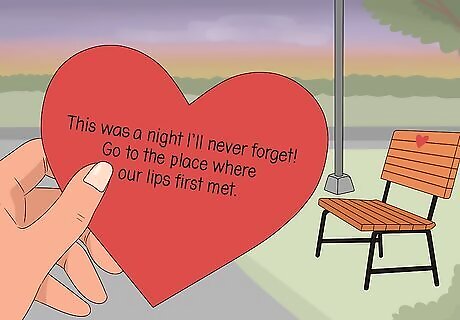
Amp up the romance with clues that talk about your feelings for your partner. You could even write the clues so that, when read together, they form an entire poem about your relationship. Great for an anniversary gift! Here are some ideas to get you going: "This was a night I'll never forget! Go to the place where our lips first met." (The place where you had your first kiss.) "You know I like to keep it light. Go to where we had our last tickle fight." "Love so fine even turtles say 'wow'—go to the spot where we exchanged vows." (The place where you got married.)
Get friends and family involved if you want.

Having people give out some of the clues makes the hunt more personal. Tell the person where they need to be and what they need to do. If they need to say anything specific to your partner, give them a written script. This works especially well if your ultimate treasure is a marriage proposal—you can include people who supported you as a couple. If you want to have a clue at a specific business, talk to the manager and get their permission. They'll usually be more than happy to help and might even throw in a little treat, such as a free cup of coffee at the café where you had your first date.
Hide the clues at each stop along the route.
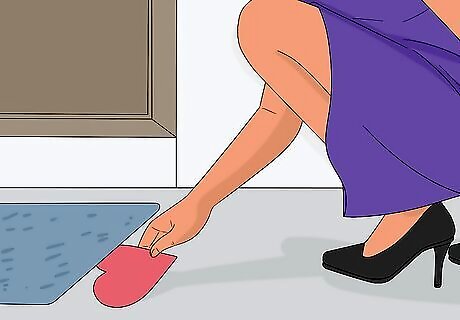
Make the clue fairly easy to find at each stop. Your partner should be able to show up at the location or find the object referenced and instantly know that they're on the right track. If your clue is outside, put it in a plastic bag to keep it from getting wet. If you have small gifts at each stop as well, tape the clue to the gift itself so your partner gets both of them at the same time.
Do a practice run from start to finish.

Fix any problems so your treasure hunt will go off without a hitch. You might be tempted to skip a practice run, but you never know what you might've overlooked. Put yourself in the mindset of your partner and pretend you don't know where you're going next. You might have a friend who wasn't around for the planning run through it with you. That way, you'll know if your clues are too confusing or difficult. Bring extra paper and other materials with you in case you need to change a clue on the fly.
Set up your partner to find the first clue.

Hand the first clue to your partner to make sure they get it. Even if you have the first clue hidden somewhere, you still might need to give them a nudge in the right direction to make sure they find it. You also want to know when they get started so you can get in position at the final destination. If your partner is starting the hunt apart from you, such as at work, have a friend deliver the first clue to them instead.
Go to the end of the route to wait for your partner.
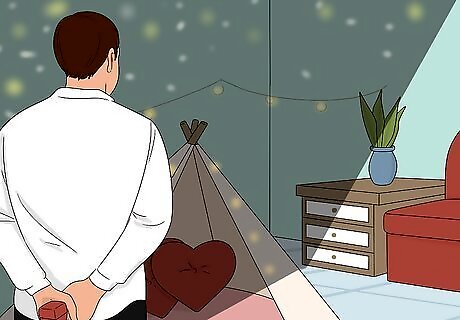
Set up the final treasure so that you're waiting when they arrive. If the final treasure is you, get dressed and in the position you want them to find you in. Make all the finishing touches you need to, then relax and wait. You might have your partner text you periodically along the route to let you know where they are, especially if you have a little work to do to set up the final reveal.















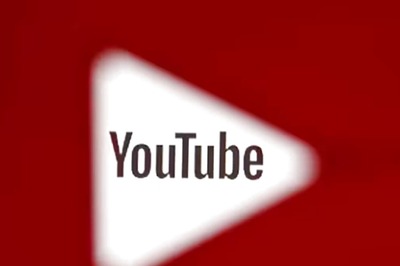
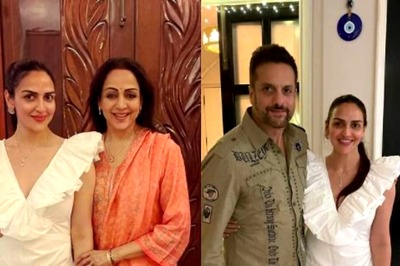



Comments
0 comment